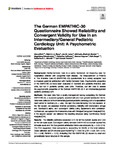The German EMPATHIC-30 Questionnaire Showed Reliability and Convergent Validity for Use in an Intermediary/General Pediatric Cardiology Unit: A Psychometric Evaluation
| dc.contributor.author | Girch, A | |
| dc.contributor.author | Rippe, RCA | |
| dc.contributor.author | Latour, Jos M | |
| dc.contributor.author | Jönebratt Stocker, M | |
| dc.contributor.author | Blendermann, M | |
| dc.contributor.author | Hoffmann, K | |
| dc.contributor.author | Heppner, H | |
| dc.contributor.author | Berger, F | |
| dc.contributor.author | Schmitt, KRL | |
| dc.contributor.author | Ferentzi, H | |
| dc.date.accessioned | 2022-07-21T15:41:07Z | |
| dc.date.issued | 2022-06-23 | |
| dc.identifier.issn | 2297-055X | |
| dc.identifier.issn | 2297-055X | |
| dc.identifier.other | 901260 | |
| dc.identifier.uri | http://hdl.handle.net/10026.1/19429 | |
| dc.description.abstract |
<jats:sec><jats:title>Background</jats:title><jats:p>Family-Centered Care is a useful framework for improving care for hospitalized children with congenital heart disease. The EMpowerment of PArents in THe Intensive Care-30 (EMPATHIC-30) questionnaire is a widely accepted tool to measure parental satisfaction with Family-Centered Care. Psychometric properties of the EMPATHIC-30 have been evaluated in neonatal and pediatric intensive care units, but not in pediatric cardiac care units. Therefore, our aim was to assess the psychometric properties of the German EMPATHIC-30 in an intermediary/general pediatric cardiology unit.</jats:p></jats:sec><jats:sec><jats:title>Methods</jats:title><jats:p>We used data from a quality management survey comprising the German EMPATHIC-30, a sociodemographic questionnaire and four general satisfaction items. Data were collected at the intermediary/general pediatric cardiology unit of a specialized heart center in Germany (<jats:italic>n</jats:italic> = 366). We split the data randomly into two subsets. In the first subset, we assessed internal consistency reliability with McDonald's omega and Cronbach's alpha, and convergent validity using Spearman's rank correlation. Furthermore, we explored the internal structure with Principal Component Analysis (PCA). In the second subset, we validated the resulting structure using Confirmatory Factor Analysis (CFA).</jats:p></jats:sec><jats:sec><jats:title>Results</jats:title><jats:p>The reliability estimates exceeded 0.70 for all five domain scores and 0.90 for the full-scale score. Convergent validity between EMPATHIC-30 domain scores/ the full-scale score and the four general satisfaction items was adequate (r<jats:sub>s</jats:sub> = 0.40–0.74). The PCA suggested three components, accounting for 56.8% of the total variance. Cross-validation via CFA showed poor model fit (χ<jats:sup>2</jats:sup> = 1545.78, χ<jats:sup>2</jats:sup>/df = 3.85, CFI = 0.70, TLI = 0.66, RMSEA = 0.13), indicating that the EMPATHIC-30 shows no clear and generalizable factor structure in this sample.</jats:p></jats:sec><jats:sec><jats:title>Discussion</jats:title><jats:p>The German version of the EMPATHIC-30 exhibited reasonable psychometric properties in an intermediary/general pediatric cardiology unit. Follow-up studies should investigate the factor structure of the EMPATHIC-30 in other pediatric inpatient care settings.</jats:p></jats:sec> | |
| dc.format.extent | 901260- | |
| dc.format.medium | Electronic-eCollection | |
| dc.language | eng | |
| dc.language.iso | eng | |
| dc.publisher | Frontiers Media | |
| dc.subject | congenital heart disease | |
| dc.subject | family-centered care | |
| dc.subject | pediatric cardiology | |
| dc.subject | psychometric properties | |
| dc.subject | internal consistency reliability | |
| dc.subject | convergent validity | |
| dc.subject | construct validity | |
| dc.title | The German EMPATHIC-30 Questionnaire Showed Reliability and Convergent Validity for Use in an Intermediary/General Pediatric Cardiology Unit: A Psychometric Evaluation | |
| dc.type | journal-article | |
| dc.type | Journal Article | |
| plymouth.author-url | https://www.webofscience.com/api/gateway?GWVersion=2&SrcApp=PARTNER_APP&SrcAuth=LinksAMR&KeyUT=WOS:000827852900001&DestLinkType=FullRecord&DestApp=ALL_WOS&UsrCustomerID=11bb513d99f797142bcfeffcc58ea008 | |
| plymouth.volume | 9 | |
| plymouth.publication-status | Published online | |
| plymouth.journal | Frontiers in Cardiovascular Medicine | |
| dc.identifier.doi | 10.3389/fcvm.2022.901260 | |
| plymouth.organisational-group | /Plymouth | |
| plymouth.organisational-group | /Plymouth/Faculty of Health | |
| plymouth.organisational-group | /Plymouth/Faculty of Health/School of Nursing and Midwifery | |
| plymouth.organisational-group | /Plymouth/REF 2021 Researchers by UoA | |
| plymouth.organisational-group | /Plymouth/REF 2021 Researchers by UoA/UoA03 Allied Health Professions, Dentistry, Nursing and Pharmacy | |
| plymouth.organisational-group | /Plymouth/Research Groups | |
| plymouth.organisational-group | /Plymouth/Research Groups/Institute of Health and Community | |
| plymouth.organisational-group | /Plymouth/Research Groups/Plymouth Institute of Health and Care Research (PIHR) | |
| plymouth.organisational-group | /Plymouth/Users by role | |
| plymouth.organisational-group | /Plymouth/Users by role/Academics | |
| dc.publisher.place | Switzerland | |
| dcterms.dateAccepted | 2022-05-26 | |
| dc.rights.embargodate | 2022-7-22 | |
| dc.identifier.eissn | 2297-055X | |
| dc.rights.embargoperiod | Not known | |
| rioxxterms.versionofrecord | 10.3389/fcvm.2022.901260 | |
| rioxxterms.licenseref.uri | http://www.rioxx.net/licenses/all-rights-reserved | |
| rioxxterms.licenseref.startdate | 2022 | |
| rioxxterms.type | Journal Article/Review |


